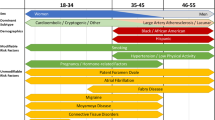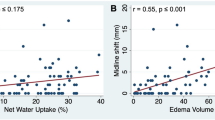Abstract
Introduction
Ischemic stroke is the second cause of death and leading cause of severe disability worldwide. A reduced features set of CT-DRAGON (age, NIHSS on admission and pre-stroke mRS) predicts 90-day functional outcome after stroke in a single center. The current study was designed to validate this adapted CT-DRAGON score in three major Belgian hospitals, in the framework of future case-mix adjustment.
Methods
This retrospective study included stroke patients, treated by thrombolysis, thrombectomy, a combination of both or neither thrombolysis or thrombectomy (conservative treatment) in 2019. Patient characteristics and 90-day mRS were collected. Multivariable logistic regression analysis of 90-day mRS 0–2 vs. 3–6 and 0–5 vs. 6 with the reduced features set was performed. Discriminative performance was assessed by the area under the receiver operating characteristic curve (AUROC).
Results
Thirty-three percent of patients (413/1243) underwent treatment. Majority of strokes was treated conservatively (n = 830, 67%), 18% (n = 225) was treated by thrombolysis, 7% (n = 88) by thrombectomy and 8% (n = 100) by thrombolysis and thrombectomy. Age, NIHSS and pre-stroke mRS were independently associated with 90-day mRS 0–2 (all p ≤ 0.0001, AUROC 0.88).
When treatment modality was added in the model, age, NIHSS, pre-stroke mRS and treatment modality were independently associated with 90-day mRS 0–2 (p < 0.0001, p < 0.0001, p < 0.0001 and p = 0.0001) AUROC 0.89). Age, NIHSS, pre-stroke mRS and treatment modality were independently associated with 90-day survival (p = 0.0001, p < 0.0001, p < 0.0001 and p = 0.008, AUROC 0.86).
Discussion
The reduced features set (age, NIHSS and pre-mRS) was independently associated with long-term functional outcome in a Belgian multicentric cohort, making it useful for case-mix adjustments in Belgian stroke centers. Treatment modality was associated with long-term outcome.

Similar content being viewed by others
Data availability
The datasets generated during and/or analyzed during the current study are available from the corresponding author on reasonable request.
Abbreviations
- AUROC:
-
Area under the receiver operating characteristic curve
- CCI:
-
Charlson comorbidity index
- CI:
-
Confidence interval
- CT:
-
Computed tomography
- DCT:
-
Door-to-CT time
- DGT:
-
Door-to-groin time
- DNT:
-
Door-to-needle time
- mRS:
-
Modified rankin scale
- NIHSS:
-
National institutes of health stroke scale
- ROC:
-
Receiver operating characteristic
References
Herpich F, Rincon F (2020) Management of acute ischemic stroke. Crit Care Med 48(11):1654–1663
Johnson CO, Nguyen M, Roth GA, Nichols E, Alam T, Abate D et al (2019) Global, regional, and national burden of stroke, 1990–2016: a systematic analysis for the Global Burden of Disease Study 2016. Lancet Neurol 18(5):439–458
Drozdowska BA, Singh S, Quinn TJ (2019) Thinking about the future: a review of prognostic scales used in acute stroke. Front Neurol 10:274
Lesenne A, Grieten J, Ernon L, Wibail A, Stockx L (2020) Prediction of functional outcome after acute ischemic stroke: comparison of the CT-DRAGON score and a reduced features set. Front Neurol 11:718
Quinn TJ, Singh S, Lees KR, Bath PM, Myint PK (2017) Validating and comparing stroke prognosis scales. Neurology 89(10):997–1002
Kremers F, Venema E, Duvekot M, Yo L, Bokkers R, Lycklama À, Nijeholt G et al (2022) Outcome prediction models for endovascular treatment of ischemic stroke: systematic review and external validation. Stroke 53:825–836
LeCouffe N, Kappelhof M, Treurniet K, Rinkel L, Bruggeman A, Berkhemer O et al (2021) A randomized trial of intravenous alteplase before endovascular treatment for stroke. N Engl J Med 385(20):1833–1844
FOD Volksgezondheid. Ziekenhuismortaliteit na hoofddiagnose van ischemische beroerte [Internet]. 2020 [cited 2022 Feb 11]. Available from: https://www.health.belgium.be/sites/default/files/9a._fiche_mortaliteit_ischemische_beroerte_nt_gevalideerd_def_nl.pdf
Holliday E, Lillicrap T, Kleinig T, Choi PMC, Maguire J, Bivard A et al (2020) Developing a multivariable prediction model for functional outcome after reperfusion therapy for acute ischaemic stroke: study protocol for the targeting optimal thrombolysis outcomes (TOTO) multicentre cohort study. BMJ Open 10(4):1–7
Ordies S, Peeters G, Lesenne A, Wouters P, Ernon L, Bekelaar K et al (2022) Interaction between stroke severity and quality indicators of acute stroke care: a single-center retrospective analysis. Acta Neurol Belg 122(1):173–180
Nogueira RG, Jadhav AP, Haussen DC, Bonafe A, Budzik RF, Bhuva P et al (2018) Thrombectomy 6 to 24 hours after stroke with a mismatch between deficit and infarct. N Engl J Med 378(1):11–21
Campbell B, Mitchell PJ, Churilov L, Yassi N, Kleinig TJ, Dowling RJ et al (2020) Effect of Intravenous tenecteplase dose on cerebral reperfusion before thrombectomy in patients with large vessel occlusion ischemic stroke: The EXTEND-IA TNK Part 2 randomized clinical trial. JAMA 323(13):1257–1265
Thomalla G, Simonsen CZ, Boutitie F, Andersen G, Berthezene Y, Cheng B et al (2018) MRI-guided thrombolysis for stroke with unknown time of onset. N Engl J Med 379(7):611–622
Albers GW, Lansberg MG, Kemp S, Tsai JP, Lavori P, Christensen S et al (2017) A multicenter randomized controlled trial of endovascular therapy following imaging evaluation for ischemic stroke (DEFUSE 3). Int J Stroke 12(8):896–905
Kuhrij LS, Wouters MW, van den Berg-Vos R, de Leeuw FE, Nederkoorn PJ (2018) The dutch acute stroke audit: benchmarking acute stroke care in the Netherlands. Eur Stroke J 3(4):361–368
Groenwold RHH (2020) Informative missingness in electronic health record systems: the curse of knowing. Diagn Progn Res 4:8
Oemrawsingh A, van Leeuwen N, Venema E, Limburg M, de Leeuw FE, Wijffels MP et al (2019) Value-based healthcare in ischemic stroke care: Case-mix adjustment models for clinical and patient-reported outcomes. BMC Med Res Methodol 19(1):229
Katzan IL, Spertus J, Bettger JP, Bravata DM, Reeves MJ, Smith EE et al (2014) Risk adjustment of ischemic stroke outcomes for comparing hospital performance a statement for healthcare professionals from the American Heart Association/American Stroke Association. Stroke 45:918–944
Belgian Health Care Knowledge Center; Michiels D, Sun Y, Thijs V, Rasit OS, Hemelsoet D et al. KCE REPORT 181As Stroke units: Doeltreffendheid en kwaliteitsindicatoren [Internet]. 2012 [cited 2022 Feb 2]. Available from: https://kce.fgov.be/sites/default/files/atoms/files/181A_Stroke_units_synthese.pdf
Amini M, van Leeuwen N, Eijkenaar F, Mulder MJHL, Schonewille W, Nijeeholt GLA et al (2020) Improving quality of stroke care through benchmarking center performance: why focusing on outcomes is not enough. BMC Health Serv Res 20(1):998
Acknowledgements
The Monitoring of Stroke Activities and Outcome Consortium includes following collaborators who were directly involved in patient care of the study. Luc Stockx, Tom De Beule, Geert Maleux, Olivier François, Ludovic Ernon, Pascal Vanelderen.
Funding
This work was supported by Interreg/SafePAT: project number Euregio Maas-Rijn EMR90, Province of Limburg Belgium, Limburg Clinical Research Center (LCRC)-Anesthesiology/Neurology Programme.
Author information
Authors and Affiliations
Consortia
Contributions
SO, AL and DM participated in the study design, checked the database for accuracy, performed the statistical analyses and drafted the manuscript. JD, RL and PV participated in the study design and revised the manuscript for important intellectual content. KB and LE supervised patient recruitment, participated in the study design and revised the manuscript for important intellectual content. JD, RL, PV and DM participated in the study design, supervised patient recruitment and helped drafting the manuscript. All authors read and approved the final manuscript.
Corresponding author
Ethics declarations
Conflict of interest
The authors have no conflicts of interest to declare that are relevant to the content of this article.
Ethical approval
This study was approved by the local independent ethics committees of AZ Groeninge Kortrijk (AZGS2020022), UZ Leuven (B371201941435) and Ziekenhuis Oost-Limburg Genk (19/0059U). The need for informed consent by patients was waived by the local Ethics Committee because of the retrospective nature of the study and all the procedures being performed as part of the routine clinical stroke care.
Consent to participate
Not applicable.
Consent for publication
Not applicable.
Additional information
Publisher's Note
Springer Nature remains neutral with regard to jurisdictional claims in published maps and institutional affiliations.
Rights and permissions
Springer Nature or its licensor (e.g. a society or other partner) holds exclusive rights to this article under a publishing agreement with the author(s) or other rightsholder(s); author self-archiving of the accepted manuscript version of this article is solely governed by the terms of such publishing agreement and applicable law.
About this article
Cite this article
Ordies, S., Lesenne, A., Bekelaar, K. et al. Multicentric validation of a reduced features case-mix set for predicting functional outcome after ischemic stroke in Belgium. Acta Neurol Belg 123, 545–551 (2023). https://doi.org/10.1007/s13760-022-02142-5
Received:
Accepted:
Published:
Issue Date:
DOI: https://doi.org/10.1007/s13760-022-02142-5




